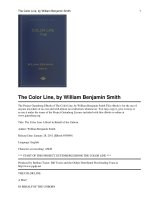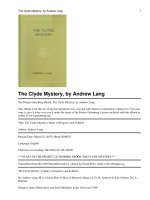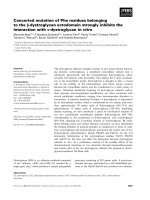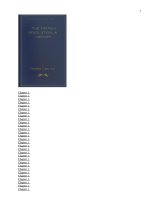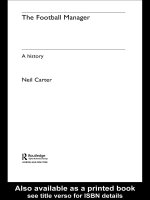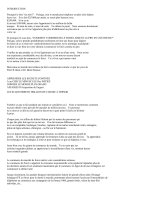- Trang chủ >>
- Khoa Học Tự Nhiên >>
- Vật lý
The Quantum Story; A History in 40 Moments
Bạn đang xem bản rút gọn của tài liệu. Xem và tải ngay bản đầy đủ của tài liệu tại đây (2.58 MB, 490 trang )
t h e qua n t u m s tory
www.pdfgrip.com
This page intentionally left blank
www.pdfgrip.com
THE
Quantum Story
a history in 40 moments
jim baggott
1
www.pdfgrip.com
1
Great Clarendon Street, Oxford ox2 6dp
Oxford University Press is a department of the University of Oxford.
It furthers the University’s objective of excellence in research, scholarship,
and education by publishing worldwide in
Oxford New York
Auckland Cape Town Dar es Salaam Hong Kong Karachi
Kuala Lumpur Madrid Melbourne Mexico City Nairobi
New Delhi Shanghai Taipei Toronto
With offices in
Argentina Austria Brazil Chile Czech Republic France Greece
Guatemala Hungary Italy Japan Poland Portugal Singapore
South Korea Switzerland Thailand Turkey Ukraine Vietnam
Oxford is a registered trade mark of Oxford University Press
in the UK and in certain other countries
Published in the United States
by Oxford University Press Inc., New York
© Jim Baggott 2011
The moral rights of the authors have been asserted
Database right Oxford University Press (maker)
First published 2011
All rights reserved. No part of this publication may be reproduced,
stored in a retrieval system, or transmitted, in any form or by any means,
without the prior permission in writing of Oxford University Press,
or as expressly permitted by law, or under terms agreed with the appropriate
reprographics rights organization. Enquiries concerning reproduction
outside the scope of the above should be sent to the Rights Department,
Oxford University Press, at the address above
You must not circulate this book in any other binding or cover
and you must impose the same condition on any acquirer
British Library Cataloguing in Publication Data
Data available
Library of Congress Cataloging in Publication Data
Data available
Typeset by SPI Publisher Services, Pondicherry, India
Printed in Great Britain
on acid-free paper by
Clays Ltd, St Ives plc
ISBN 978–0–19–956684–6
10 9 8 7 6 5 4 3 2 1
www.pdfgrip.com
For MSS,
because every student deserves
at least one great teacher
www.pdfgrip.com
This page intentionally left blank
www.pdfgrip.com
CON T EN TS
Preface
Prologue: Stormclouds
London, April 1900
xiii
1
PART I: QUANTUM OF ACTION
1 The Most Strenuous Work of My Life
Berlin, December 1900
7
2 Annus Mirabilis
Bern, March 1905
17
3 A Little Bit of Reality
Manchester, April 1913
25
4 la Comộdie Franỗaise
Paris, September 1923
34
5 A Strangely Beautiful Interior
Helgoland, June 1925
43
6 The Self-rotating Electron
Leiden, November 1925
51
7 A Late Erotic Outburst
Swiss Alps, Christmas 1925
60
PART II: QUANTUM INTERPRETATION
8 Ghost Field
Oxford, August 1926
71
9 All This Damned Quantum Jumping
Copenhagen, October 1926
79
vii
www.pdfgrip.com
the quantum story
10 The Uncertainty Principle
Copenhagen, February 1927
87
11 The ‘Kopenhagener Geist’
Copenhagen, June 1927
95
12 There is No Quantum World
Lake Como, September 1927
103
PART III: QUANTUM DEBATE
13 The Debate Commences
Brussels, October 1927
115
14 An Absolute Wonder
Cambridge, Christmas 1927
126
15 The Photon Box
Brussels, October 1930
133
16 A Bolt from the Blue
Princeton, May 1935
141
17 The Paradox of Schrödinger’s Cat
Oxford, August 1935
149
Interlude: The First War of Physics
Christmas 1938–August 1945
159
PART IV : QUANTUM FIELDS
18 Shelter Island
Long Island, June 1947
171
19 Pictorial Semi-vision Thing
New York, January 1949
181
20 A Beautiful Idea
Princeton, February 1954
193
21 Some Strangeness in the Proportion
Rochester, August 1960
204
22 Three Quarks for Muster Mark!
New York, March 1963
214
viii
www.pdfgrip.com
contents
23 The ‘God Particle’
Cambridge, Massachusetts, Autumn 1967
225
PART V : QUANTUM PARTICLES
24 Deep Inelastic Scattering
Stanford, August 1968
237
25 Of Charm and Weak Neutral Currents
Harvard, February 1970
247
26 The Magic of Colour
Princeton/Harvard, April 1973
256
27 The November Revolution
Long Island/Stanford, November 1974
265
28 Intermediate Vector Bosons
Geneva, January/June 1983
275
29 The Standard Model
Geneva, September 2003
285
PART VI: QUANTUM REALIT Y
30 Hidden Variables
Princeton, Spring 1951
297
31 Bertlmann’s Socks
Boston, September 1964
306
32 The Aspect Experiments
Paris, September 1982
318
33 The Quantum Eraser
Baltimore, January 1999
328
34 Lab Cats
Stony Brook/Delft, July 2000
339
35 The Persistent Illusion
Vienna, December 2006
349
PART VII: QUANTUM COSMOLOGY
36 The Wavefunction of the Universe
Princeton, July 1966
ix
www.pdfgrip.com
361
the quantum story
37 Hawking Radiation
Oxford, February 1974
372
38 The First Superstring Revolution
Aspen, August 1984
381
39 Quanta of Space and Time
Santa Barbara, February 1986
391
40 Crisis? What Crisis?
Durham, Summer 1994
399
Epilogue: A Quantum of Solace?
Geneva, March 2010
407
Notes and Sources
Bibliography
Plate Acknowledgements
Index
411
441
448
451
x
www.pdfgrip.com
ABOU T T HE AU T HOR
Jim Baggott is an award-winning science writer. A former academic scientist, he now works as an independent business consultant but maintains a broad interest in science, philosophy, and history, and continues
to write on these subjects in his spare time. His previous books have been
widely acclaimed and include:
Atomic: The First War of Physics and the Secret History of the Atom Bomb 1939–49
(Icon Books, 2009);
A Beginner’s Guide to Reality (Penguin, 2005);
Beyond Measure: Modern Physics, Philosophy and the Meaning of Quantum Theory (Oxford University Press, 2004);
Perfect Symmetry: The Accidental Discovery of Buckminsterfullerene (Oxford
University Press, 1994); and
The Meaning of Quantum Theory: A Guide for Students of Chemistry and Physics
(Oxford University Press, 1992).
xi
www.pdfgrip.com
This page intentionally left blank
www.pdfgrip.com
PR EFACE
The last century was defined by physics. From the minds of the world’s
leading physicists there flowed a river of ideas that would transport mankind to the very pinnacle of wonder and to the very depths of despair.
This was a century that began with the certainties of absolute knowledge
and ended with the knowledge of absolute uncertainty. It was a century
in which physicists developed theories that would deny us the possibility
that we can ever properly comprehend the nature of physical reality. It
was also a century in which they built weapons with the capacity utterly
to destroy this reality.
Almost everything we think we know about the nature of our world
comes from one theory of physics. This theory was discovered and
refined in the first thirty years of the twentieth century and went on to
become quite simply the most successful theory of physics ever devised.
Its concepts underpin much of the twenty-first century technology that
we have learned to take for granted.
But this success has come at a price, for it has at the same time completely undermined our ability to make sense of the world at the level of
its most fundamental constituents.
Rejecting the elements of uncertainty and chance implied by this new
theory, Albert Einstein once famously declared that ‘God does not play
dice’. Niels Bohr claimed that anybody who is not shocked by the theory
has not understood it. The charismatic American physicist Richard Feynman went further: he claimed that nobody understands it. To anyone
tutored in the language and the logic of classical physics, this theory is at
once mathematically challenging, maddeningly bizarre, and breathtakingly beautiful.
This is quantum theory, and this book tells its story.
xiii
www.pdfgrip.com
the quantum story
If we fix on Max Planck’s discovery of his ‘quantum of action’ in December 1900 as the historical origin of the quantum theory, then as I write this
theory is 110 years old. Time enough, you would have thought, for physicists to get to grips with it and understand what it means. Time enough
to come to terms with what quantum theory has to say about chance and
causality and the nature of physical reality. And yet, if anything, the sense
of shock has increased, not diminished, with the passing of time.
While nobody really understands how quantum theory actually works,
the rules of its application are unquestioned and the accuracy and precision of its predictions are unsurpassed in the entire history of science.
Although heated debate continues about how quantum theory should
be interpreted, there can be no debate about whether or not the theory
is fundamentally correct.
For more than four hundred years we nurtured the belief (should that,
perhaps, be faith?) that evidence-based investigation meeting scientific
standards of rigour would reveal the true mechanisms of nature. And
yet when the mechanisms of nature were revealed to be quantum mechanisms, the worlds of science and philosophy were set on a collision
course. Instead of truth and comprehension, we got deeply unsettling
questions about what we can ever hope to know about the world. Quantum theory pushed us to the edge of an epistemological precipice. Since
the mid-1920s we have lived in fear of stepping over the edge.
This book is a celebration of this wonderful yet wholly disconcerting
theory, from its birth in the porcelain furnaces used to study black-body
radiation in 1900 to the promise of stimulating new quantum phenomena to be revealed by CERN’s Large Hadron Collider, over a century later.
It is a history told in forty ‘moments’, significant moments of truth or
turning points in the theory’s development.
This history takes us on a long journey. Part I deals with Planck’s discovery in 1900 and traces the development of early quantum theory
through Einstein’s light-quantum hypothesis, Bohr’s quantum theory
of the atom, Louis de Broglie’s dual wave–particle hypothesis, Werner
Heisenberg’s matrix mechanics, the puzzling phenomenon of electron
spin, and Wolfgang Pauli’s exclusion principle. This section concludes
with Erwin Schrödinger’s ‘late erotic outburst’, which led him to wave
mechanics in December 1925.
xiv
www.pdfgrip.com
pr eface
In Part II, the book traces the development of the Copenhagen interpretation of quantum theory. We move from Max Born’s interpretation
of the significance of Schrödinger’s wavefunction in 1926, via the intense
debates between Bohr, Heisenberg, and Schrödinger on the reality of
quantum jumps, the development of Heisenberg’s uncertainty principle,
to Bohr’s Como lecture in September 1927.
At this point, Einstein, an early champion of quantum theory, became
one of the theory’s most determined critics. Part III describes the Bohr–
Einstein debate, one of the most profound debates in the history of
science. We begin with Einstein’s first thought experiments, outlined
to a pensive audience during the fifth Solvay conference in October
1927, before moving on to the Einstein, Podolsky, Rosen argument and
Schrödinger’s famous cat paradox in 1935. The book pauses briefly in
this section to catch the ‘absolute wonder’ that is Paul Dirac’s relativistic
quantum theory of the electron.
To study quantum theory is to study the physicists who made it. My
original intention was to write a ‘biography’ of quantum theory based
on the biographies of the physicists who forged it and refined it.1 Many
of these same physicists also played crucial roles in the development of
the world’s first atomic weapons, and I had intended to include a long
section on their wartime exploits. In an already hopelessly ambitious
book, this was an ambition too far. This section became a book in itself,
titled Atomic: The First War of Physics and the Secret History of the Atom Bomb,
1939–49, published in 2009 by Icon Books. With the publisher’s permission I have included here an interlude, based on extracts from this earlier
book and focused primarily on the infamous meeting in September 1941
between Bohr and Heisenberg in Nazi-occupied Copenhagen.
As the physicists picked up the pieces of their academic careers after
the war, quantum theory was in crisis. Part IV describes the series of
crisis meetings that culminated in the development of quantum electrodynamics, by Julian Schwinger, Richard Feynman, Sin-itiro Tomonaga, and Freeman Dyson. This was followed in 1954 by the unheralded
development of quantum field theory based on local gauge symmetry
1
I wrote the original proposal for this book at a time when ‘biographies’ of inanimate subjects were still popular.
xv
www.pdfgrip.com
the quantum story
by Chen Ning Yang and Robert Mills. Sheldon Glashow, Abdus Salaam,
and Stephen Weinberg went on to formulate early versions of a unified electro-weak theory in 1960, and predicted the existence of ‘heavy
photons’, the W and Z particles. Although much of this effort was
summarily dismissed by the physics community, this was a time of
unprecedented fertility in theoretical physics. It culminated in Murray
Gell-Mann’s 1963 theory of quarks and the introduction of symmetrybreaking and the Higgs mechanism in 1967.
At this point, the history of quantum theory becomes synonymous
with the history of particle physics. In Part V the book examines the
roles of ever larger and more expensive particle accelerators and colliders in furnishing the evidence for the particular collection of quantum
field theories that has become known as the Standard Model of particle
physics. This section begins with the discovery, at the Stanford Linear
Accelerator Center (SLAC) in 1968, that the proton possesses an internal structure. This is followed by the discoveries of a hypothetical charm
quark and the colour force described by Gell-Mann and Harald Fritzsch’s
theory of quantum chromodynamics.
The experimental observation of the J/ψ meson (formed from a charm
and anti-charm quark), simultaneously at SLAC and at Brookhaven
National Laboratory in the ‘November revolution’ of 1974, and the subsequent observation of the W and Z particles at CERN in 1983, set the
physicists on the path to the Standard Model. This model is constructed
from three ‘generations’ of matter particles consisting of leptons (electrons and neutrinos) and quarks that interact through the exchange of
force particles—photons, W and Z particles, and colour force gluons.
There is as yet no room in the Standard Model for gravity. This section
concludes by looking over the shoulders of the physicists gathered at
CERN as they celebrate their successes in September 2003.
At this stage the book steps backwards, to 1951, and David Bohm’s
growing unease over the implications of the Copenhagen interpretation.
Encouraged by Einstein, Bohm goes on to make further refinements to the
Einstein, Podolsky, Rosen argument, bringing their thought experiment
into the realms of practicality. Bohm goes on to develop an elaborate
‘hidden variable’ alternative to conventional quantum theory.
xvi
www.pdfgrip.com
pr eface
From these beginnings, Part VI traces the development of contemporary experimentation designed to probe the very nature of physical
reality itself. The book recounts the development in 1964 of John Bell’s
theorem, and Bell’s inequality, which exposed the true nature of Einstein’s
challenges and provided a straightforward test of local versus non-local
reality. The first definitive experiments were performed by Alain Aspect
and his colleagues in 1981 and 1982. The quantum world was shown to be
determinedly non-local.
There followed a series of experiments demonstrating the truly incomprehensible nature of this world, leaving the committed realist grasping
for straws. These included Marlan Scully and Kai Drühl’s quantum eraser
experiment and experiments demonstrating interference in macroscopic
quantum objects, inanimate laboratory versions of Schrödinger’s infamous
cat. This section concludes with a description of some 2006 experiments
by Anton Zeilinger and his colleagues, designed to test a further inequality
devised by Anthony Leggett. The results strongly suggest that we can no
longer assume that the particle properties we measure necessarily reflect
or represent the properties of the particles as they really are.
These experiments tell us rather emphatically that we can never
perceive reality ‘as it really is’. We can only reveal aspects of an empirical reality that depend on the nature of the instruments we use and the
questions we ask. Quantum physics, it seems, has completed its transformation into experimental philosophy.
The book closes with Part VII, which describes the efforts to forge
together the two great physical theories of the twentieth century—
quantum theory and general relativity—into a theory of quantum
gravity or, alternatively, into a ‘theory of everything’, capable in principle of describing everything in the universe. This section begins with the
development of canonical quantum gravity in the form of the Wheeler–
DeWitt equation. Applying quantum field theory to the curved space–
time around a black hole, Stephen Hawking discovered in 1974 that black
holes ‘ain’t so black’.
The first superstring revolution in August 1984 promised to provide
a theory which could not only explain all the particles of the Standard
Model but could also accommodate the graviton, the purported field
xvii
www.pdfgrip.com
the quantum story
particle of the gravitational force. This early promise faded, however, as
different variants of superstring theory emerged and it lost any sense of
uniqueness. Around the same time, the canonical approach was resurrected in the form of loop quantum gravity. Superstring theory experienced something of a renaissance in March 1995, in the second superstring
revolution, and today dominates contemporary theoretical physics.
But there is growing impatience with the superstring programme’s
obsession with obscure hidden dimensions and its inability to make any
kind of testable prediction. As has happened so often in its glorious 110year history, quantum theory is once again in crisis. This section closes
with an exploration of the role that interpretation, an obsession among
physicists since the theory’s inception, might still have yet to play.
The book concludes optimistically with, if you will, a quantum of solace. It has cost £3.5 billion and frustratingly blew up days after it was first
switched on in September 2008, but the Large Hadron Collider (LHC)
at CERN in Geneva gives some hope of resolving the current crisis. At
worst, the LHC will simply confirm the existence of the Higgs boson,
validating the mechanism of spontaneous symmetry-breaking, explaining how particles acquire mass, and putting the icing on the cake of the
Standard Model. At worst, the LHC will provide answers.
At best, the LHC will turn up some bizarre new experimental facts; facts
that simply can’t be accommodated in the current quantum field theories
that constitute the Standard Model, and the crisis will deepen. Physics will
then truly come alive once again. Only from the depths of despair are we
likely to see the breakthroughs needed to propel quantum theory on the
next stage of its journey. At best, the LHC will beg questions.
Many of the ‘moments’ I have chosen to describe in this book suggest
themselves as unambiguously key events in quantum theory’s history.
Others are a little less obvious and some have been chosen in an effort
to maintain narrative consistency and flow. Whilst I make no apologies
for my choices, I am very conscious of the risk that, taken together, these
moments may be perceived to describe a smooth, irresistible progression
towards some inexorable scientific truth.
This is just not how science works. It has not been possible to describe
here all the blind alleys, the dead ends, the theories that dominated for
xviii
www.pdfgrip.com
pr eface
a time only to be replaced by alternatives better able to explain the data.
The reality of scientific endeavour is profoundly messy, often illogical,
deeply emotional, and driven by the individual personalities involved as
they ‘sleepwalk’ their way to a temporary scientific truth.
My thanks go to Latha Menon, my editor at Oxford University Press,
for her patience, fortitude, and ability to channel my ambitions in more
practical directions. I owe a debt of thanks to Anthony Leggett, Carlo
Rovelli, and Peter Woit who read and commented on the draft manuscript. It goes without saying that all the errors, misconceptions, and
misinterpretations that remain are entirely my fault.
I hope this book will stand as a testament to the intellectual and psychological challenge posed by a quantum theory so profoundly at odds
with a common-sense conception of the world, and to those great physicists who were able to rise to this challenge. A testament to what can be
achieved through the application of a theory that nobody understands.
Jim Baggott
Reading, July 2010
xix
www.pdfgrip.com
This page intentionally left blank
www.pdfgrip.com
P ROLOG U E
Stormclouds
London, April 1900
At the beginning of the twentieth century there were plenty of reasons
for believing that the great journey that was physics was close to reaching its final destination.
The structure that was classical physics had been built on foundations
laid by Isaac Newton’s grand synthesis in the seventeenth century. A further two hundred years of scientific endeavour had created a seemingly
unassailable model of the world. This model explained everything, from
the interplay of force and motion in the dynamics of moving objects,
thermodynamics, optics, electricity, magnetism, and gravitation. Its
scope was vast. It described everything, from the familiar objects of
everyday experience on earth to objects in the furthest reaches of the
visible universe. There seemed little room for doubt about the basic correctness of classical physics, its essential truth.
But Newton had been obliged to compromise. He needed an absolute space and an absolute time to provide a framework against which
all motion could be measured. Much more worrisome was the force of
gravity. In all of Newton’s mechanics, force is a physical phenomenon
exerted through contact between one object and another. Newton’s gravity was an influence felt through a curious, mutual action-at-a-distance
between objects. He was accused of introducing ‘occult agencies’ into his
otherwise rational, physical, and mathematically precise description of
the world. In a General Scholium, added to the 1713 second edition of his
most famous work Philosophiæ Naturalis Principia Mathematica (The Mathematical Principles of Natural Philosophy), he wrote:
1
www.pdfgrip.com
the quantum story
Hitherto we have explain’d the phænomena of the heavens and of our
sea, by the power of Gravity, but have not yet assign’d the cause of this
power . . . I have not been able to discover the cause of those properties of
gravity from phænomena, and I frame no hypotheses.
Gravity was a force that was somehow exerted instantaneously, with no
intervening medium other than a hypothetical, all-pervading, tenuous
form of matter called the ether that was thought to fill the void.
Newton had also extended the scope of his mechanics to describe light,
concluding that light consists of tiny particles, or corpuscles. Two of his
contemporaries, English natural philosopher Robert Hooke and Dutch
physicist Christiaan Huygens, had argued that light consists instead of
waves. Such was Newton’s standing and authority that the corpuscular
theory held sway for a hundred years.
In a series of papers read to the Royal Society in London between 1801
and 1803, nearly eighty years after Newton’s death, English physicist
Thomas Young revived the wave theory as the only possible explanation
of light diffraction and interference phenomena. In one experiment, commonly attributed to Young, it was shown that when passed through two
narrow, closely spaced holes or slits, light produces a pattern of bright
and dark fringes. These are readily explained in terms of a wave theory of
light in which the peaks and troughs of the light waves from the two slits
start out ‘in step’ (or in phase). Where a peak of one wave is coincident
with a peak of another, the two waves add and reinforce. This is called
constructive interference, and gives rise to a bright fringe. Where a peak
of one wave is coincident with a trough of another, the two waves cancel.
This is called destructive interference, and gives a dark fringe.
Despite the apparently inescapable logic of his explanation, Young’s
views were roundly rejected by the physics community at the time, with
some condemning his explanation as ‘destitute of every species of merit’.
The wave theory of light was to prove ultimately irresistible, however.
In the 1860s Scottish physicist James Clerk Maxwell fused electricity
and magnetism into a single theory of electromagnetism. The intimate
connection between electricity and magnetism had been established for
some years, most notably through the extraordinary experimental work
of Michael Faraday at London’s Royal Institution. Drawing on analogies
with fluid mechanics, Maxwell proposed the existence of electromag-
2
www.pdfgrip.com
prologue stor mclods
light
source
Wavefront
fig 1 Thomas Young discovered that passing light through two narrow, closely-spaced
holes or slits would produce a pattern of alternating light and dark fringes. These could
only be explained, Young, believed, in terms of a wave theory of light in which overlapping wavefronts interfere constructively (bright fringe) and destructively (dark fringe).
netic fields whose properties are described by a set of complex differential equations.2
Maxwell had made no assumptions about how these fields were supposed to move through space. Nevertheless, when the equations are cast
in a way that makes explicit the interdependence of the electric and magnetic fields as they move through free space, they point unambiguously
to a wave-like motion. And, as Maxwell himself discovered, the speed of
these electromagnetic waves is precisely the speed of light.
But waves are disturbances in something. Waves rippling on the surface of a pond are disturbances in water. The noise of a tree falling in a
forest is derived from sound waves propagating through the air. All wave
motion requires a medium to support it, so precisely what medium was
meant to support light waves? The ether was once again called to duty.
Faraday had rejected the notion of the ether, but Maxwell leaned heavily
on the concept in developing his theory.
It seemed that neither gravity nor electromagnetism could be
explained without the ether. But if the ether existed, then certain physical
2
The historical development of Maxwell’s equations is described in detail in Crease, A Brief
Guide to the Great Equations.
3
www.pdfgrip.com
the quantum story
consequences could be anticipated. The earth’s motion through space
could be expected to drag the ether along with it. And, just as a sound
wave will appear to be travelling faster if a strong wind moves the air that
carries it, so a light wave is expected to appear to travel faster if caught in
an ‘ether wind’. This meant that there should be measurable differences in
the speed of light depending on the direction it is travelling relative to the
earth’s motion through space. This proposal was put to its most stringent
test by American physicists Albert Michelsen and Edward Morley in 1887.
They could find no evidence for a drag effect and hence no evidence for
relative motion between the earth and the ether.
As the century turned, Newton’s grand mechanical design remained
largely unassailable. Physicists were either willing to forgive gravitational
action-at-a-distance or quietly forget that this was a problem, because the
structure worked so wonderfully well and it was so obviously right. Newton
had been shown to be fallible on the question of light, but it was now clear
how a wave theory of light fitted into the equally wonderful structure created
by Maxwell, despite some hesitancy on the question of the wave medium.
We could, perhaps, forgive physicists of the late nineteenth century their
sense of triumph. In 1900, the great British physicist Lord Kelvin (William
Thomson) famously declared to the British Association for the Advancement of Science that: ‘There is nothing new to be discovered in physics
now. All that remains is more and more precise measurement.’
It is a famous declaration, one that characterizes the mood of the
time, although, it seems, one that may well be apocryphal.3 The simple
truth is that in the last decades of the nineteenth century the mechanical
structure of classical physics was beginning to creak under the strain of
accumulating contrary evidence. In April 1900, Kelvin delivered a lecture
to the Royal Institution concerned with what he perceived to be nineteenth
century ‘clouds’ over the dynamical theory of heat and light.4
Not triumphalist, but prescient.
The stormclouds were gathering. But nobody could tell precisely where
the storm would break.
3
In his 2007 biography of Einstein, Walter Isaacson explained that he could find no direct
evidence that Kelvin had made this pronouncement.
4
See Kragh, Quantum Generations, p. 9.
4
www.pdfgrip.com
